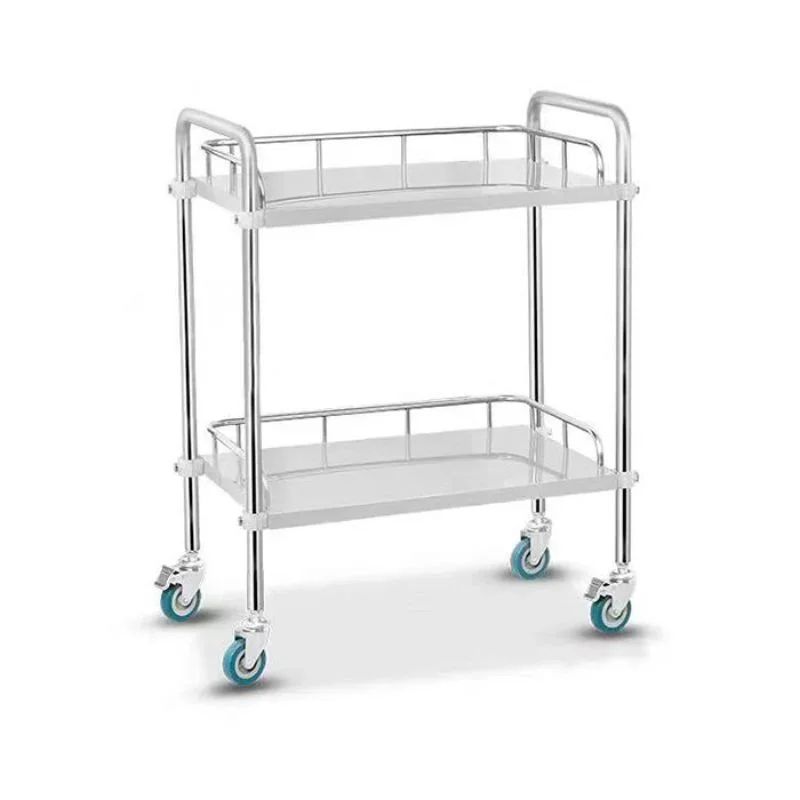No products in the cart.
Blog
Medical Trolleys: Fundamental Tools for Healthcare Efficiency
Medical carts are vital tools in healthcare settings, designed to streamline the organization and accessibility of medical supplies and equipment. These versatile and mobile units improve workflow efficiency, reduce response times, and ultimately enhance patient care. This article explores medical trolley’ types, benefits, and critical features, highlighting their importance in modern healthcare.
What Are Medical Trolleys?
Medical trolleys, also known as hospital carts or medical carts, are portable units with multiple shelves and compartments designed to carry and store essential medical tools, medications, and equipment. These trolleys are widely used in hospitals, clinics, nursing homes, and other healthcare facilities to help medical staff transport items quickly and efficiently across different areas.
The design of medical carts varies depending on their intended use. Still, their primary function remains the same: make sure easy access to critical medical items, which is essential in urgent situations.
Types of Medical Carts
Medical carts come in various forms, each catering to specific needs in healthcare. Some of the most common types include:
- Anesthesia Trolleys
These trolleys have specialized compartments for storing anaesthesia drugs, syringes, and related supplies. Anaesthesia trolleys help anesthesiologists keep all necessary items organized and accessible during procedures.
- Crash Carts
Crash carts, or emergency trolleys, are designed for rapid response situations. They contain life saving medications, defibrillators, oxygen masks, and other emergency supplies, making them critical during cardiac arrest or other emergencies. Crash carts are commonly seen in emergency rooms and ICU settings.
- Medication Trolleys
Medication trolleys store and transport medications safely within healthcare facilities. They include secure locking mechanisms to prevent unauthorized drug access, ensuring patient safety and compliance with regulations.
- Treatment Trolleys
Used for general treatment purposes, treatment trolleys carry items like bandages, wound care supplies, and other medical tools needed for routine patient care. They are typically found in patient wards and outpatient areas.
- Procedure Trolleys
Procedure trolleys are specialized for specific medical procedures, such as IV insertion or blood draws. They are designed to carry all necessary tools and equipment for these tasks, allowing healthcare professionals to perform procedures more efficiently.
Key Features of Medical Trolley
When choosing a medical trolley, healthcare providers look for specific features that enhance functionality and ease of use. The following are some of the most important features to consider:
- Mobility and Stability
Medical carts have high-quality wheels that allow easy manoeuvrability across various surfaces. Many models have locking wheels to provide stability, especially during procedures.
- Durability and Material
Medical carts are usually made from durable materials like stainless steel, aluminium, or ABS plastic to withstand frequent use and cleaning. These materials are also corrosion-resistant, ensuring the trolleys remain in good condition.
- Organizational Compartments
Suitable medical carts have multiple shelves, drawers, and compartments, allowing for efficient organization. Adjustable shelves and drawer dividers can be helpful in customizing storage space according to the specific needs of each medical setting.
- Safety Features
Many medical carts have built-in locking mechanisms to secure medications and sensitive equipment, protecting patients and staff. Safety rails and anti-slip surfaces are standard features to prevent items from falling during transport.
- Ease of Cleaning
In healthcare, hygiene is paramount. Medical carts are designed with smooth surfaces and rounded edges for easy cleaning and disinfection. This feature helps prevent the spread of infections and maintains a sterile environment.
Benefits of Using Medical Carts in Healthcare
Medical trolleys offer several advantages, making them indispensable in healthcare facilities. Here are some of the main benefits:
Sweetened Efficiency
Medical carts improve workflow by allowing healthcare professionals to access necessary tools and supplies without leaving the patient’s side. This saves valuable time, especially during critical procedures, and helps ensure smoother patient care.
Improved Patient Care
With medical carts, healthcare staff can respond to patients’ needs more quickly, whether administering medication, conducting a procedure, or responding to an emergency. This immediate access contributes to better patient outcomes.
Reduced Risk of Errors
The organization offered by medical carts minimizes the risk of misplacing or losing important supplies, reducing the likelihood of errors. This is especially important when dealing with medications, as proper organization can prevent dosage mistakes.
Increased Mobility
Medical carts provide the mobility needed to move equipment and supplies seamlessly across departments, ensuring that healthcare professionals can focus on patient care rather than logistical issues.
Conclusion:
In the healthcare sector, medical carts are vital because they provide a valuable way to arrange and move necessary medical supplies. Whether used as a pharmaceutical trolley for regular visits or as a crash cart for emergencies, these multipurpose gadgets support healthcare workers, enhance patient care, and expedite operations. Healthcare facilities may increase productivity and make sure they are ready for any medical emergency by selecting a suitable medical trolley.
Hospitals, clinics, and other healthcare organizations can provide effective and responsive patient care by investing in high-quality medical trolleys.


